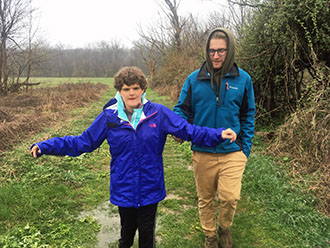Hikers with ID
Matching each hiker with the right trails can help hiking planners and partners to find the perfect hike.
How can I find trails now?
A detailed inventory of hikes in our region reveals just how overwhelming the choices are for beginners
How are trails rated?
The criteria for rating trails of varying levels of difficulty are not that useful to beginning hikers with ID!
Access adventure
Using existing data to carefully cali- brate hikes that help beginning hikers grow over time into adventurous ones.
Building a trail inventory
Applying progressive access to the inventory of trails in our region reveals a wealth of great options.
Evidence-based practices
How can you adapt core EBPs identified for other skills and behaviors to hiking?
A community of hikers!
Imagine creating new social connections, and building a regional trail inventory together!
Coming soon
Building a baseline and a routine
Progressive access helps planners to get to know their hiker, and establish a functional routine
April 10, 2020
 Hiking with her older brotherFinding your Baseline
Hiking with her older brotherFinding your Baseline
Our overall goal for this first step is to create a weekly / bi-weekly hiking routine that involves 60 to 90 minute walks that a hiker finds enjoyable and invigorating. But where do we start, and how do we build capacity? As with any good intervention, we need a baseline. And as with any good experiment, we need to understand the variables we are working with.
Aim for a comfortable walk on a flat paved trail segment that can be completed in 30-60 minutes.
Our first goal should be to give a new hiker a short walk in nature that they enjoy. For anyone who struggles to walk any reasonable distance or who because anxious in unfamiliar situations, we might start with a 30 minute walk. For everyone else, a 45-60 minute walk will suffice.
Key definitionWhen we describe a trail as paved, we are including trails with a stone dust surfaceWe eliminate all variables here except for time spent hiking. For example, we do not set any expectations about the distance we will cover (though we will carefully note it!). And we eliminate any other variable that might contribute to increased difficulty, by selecting a flat, wide section of paved trail. Once we have identified the distance we can happily cover in 30-60 minutes on an flat trail, we try to repeat this experience at least 2 more times on the same trail (while also trying to ensure a steady pace), and finally we try to replicate the success on a second trail . Once we have completed this, we have established a baseline from which we can build.
Use these first hikes to get to know what your hiker likes and does not hike, and how they communicate this.
In fact, we are doing more than just establishing a baseline; we are also getting the know what factors are important to our hiker. What do they enjoy? Sun or the shade? Walking fast or slow? The solitude of a quiet preserve or the bustle of a busy urban or suburban park? And if they do not use words you can understand, how do they communicate this? Margot likes all kinds of hikes (as long as we are careful not to make them too difficult), and she lets us know through her smiles and coos. She now likes to greet other hikers, making busier trails more interesting.
And we are learning what might make a hike less enjoyable, aside from the more predictable factors described later, like the length and the slope of a trail. Do they quickly become uncomfortable when they are cold, or hot, or sweaty? And if they do not use words you can understand, how will you know? For hikers who are non-verbal, this might include different kinds of behaviors... For example, Margot frowns and grimaces when she is a little frustrated, whines as it worsens, and then pinches or hits us or slaps her head when she has just about had enough. It is almost impossible to introduce a new fitness activity like hiking without also introducing some level of discomfort. These first hikes can help to identify how much difficulty might simply be too much.
Building a functional hiking routine
In addition to establishing a baseline of the distance that can be comfortably covered in a 30 to 60 minute hike, we are also beginning to build a once to twice a week hiking routine. For hikers, the routine will initially be straightforward; aside from perhaps changing into better walking shoes, and making sure to bring a jacket, this outing will feel like just another outing in the community.
Build a routine that partners and planners can comfortably and reliably implement once or twice a week.The people here who might find the new routine challenging are, however, the other adults - the hiking partners and planners! Hiking partners will have to become used to going through a quick mental checklist before they set out. Are there any personal needs that should be taken care of before they set out?
Another important routine? Checking the weather and deciding how a hiker should be dressed. When establishing a baseline and routine, it is best to avoid days that are especially hot (e.g., above 80), humid, cold (e.g., below 45) or rainy. Otherwise, you may be unable to separate the impact of the weather on a hiker's discomfort from the impact of other factors, like the length or the difficulty level of the trail itself.. As we will see later, a good planner can always make adjustments to expectations based on changes in the weather, but having the right clothing makes a big difference. And making sure that hikers have the right shoes becomes more important as they become more adventurous.
Partners who are anxious because they have had bad experiences on other community outings should remind themselves to take a deep breath (or maybe a couple!) before they set out. With proper planning, hiking is likely to be one of the safest outings to try...nonetheless, partners might find it difficult to shake a bad experience. Partners who are often preoccupied with how well a hiker is doing should also take a deep breath (or maybe a couple!). Hiking is not meant to be a competition - it has to be enjoyable for the hiker AND the partner to be successful. So enjoy it!!
But no routine can be created for a hiker or a partner unless you can hike at least once a week, and so it falls on those planning hikes to find a time that works for everyone. While a short hike close to the house might only require a little more than an hour long outing, a longer hike can easily become an hour and a half to a two hour commitment. A regular weekend hike can be a great opportunity to get everyone out of the house. Planners should avoid times when a hiker might typically be tired (like right after school), and consider pairing a hike with another activity that hikers really enjoy.
See a summary
Or read more detailed descriptions
Sample Guidelines

Accessible Trail Adventures

![]() A blog on how to plan accessible trail adventures - walking. hiking, biking, etc - for people of all abilities.
A blog on how to plan accessible trail adventures - walking. hiking, biking, etc - for people of all abilities.

Warming up after a cold hike!?!
Design by Jeremy Goldberg
Muse-Themes.com
The logo is adapted from Joaquim Alves Gaspar's drawing of Pedro Reinel's compass rose.
Connect
Hikers with ID
Matching each hiker with the right trails can help hiking planners and partners to find the perfect hike.
How can I find trails now?
A detailed inventory of hikes in our region reveals just how overwhelming the choices are for beginners
How are trails rated?
The criteria for rating trails of varying levels of difficulty are not that useful to beginning hikers with ID!
Access adventure
Using existing data to carefully cali- brate hikes that help beginning hikers grow over time into adventurous ones.
Building a trail inventory
Applying progressive access to the inventory of trails in our region reveals a wealth of great options.
Evidence-based practices
How can you adapt core EBPs identified for other skills and behaviors to hiking?
A community of hikers!
Imagine creating new social connections, and building a regional trail inventory together!
Coming soon